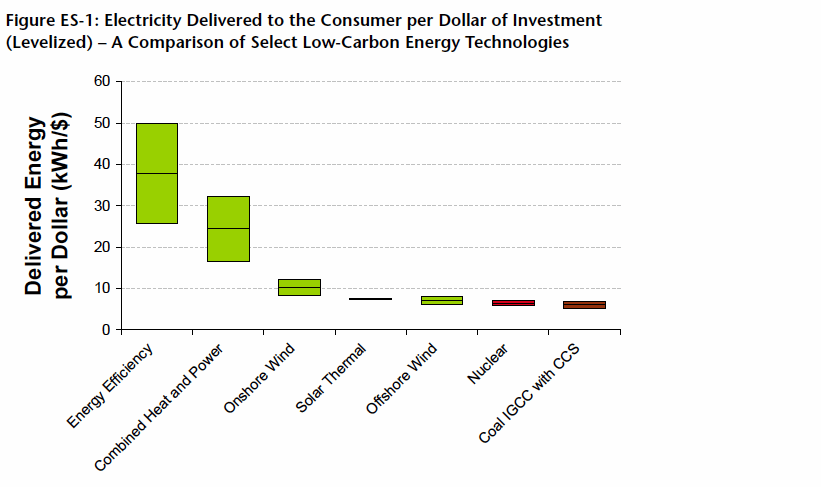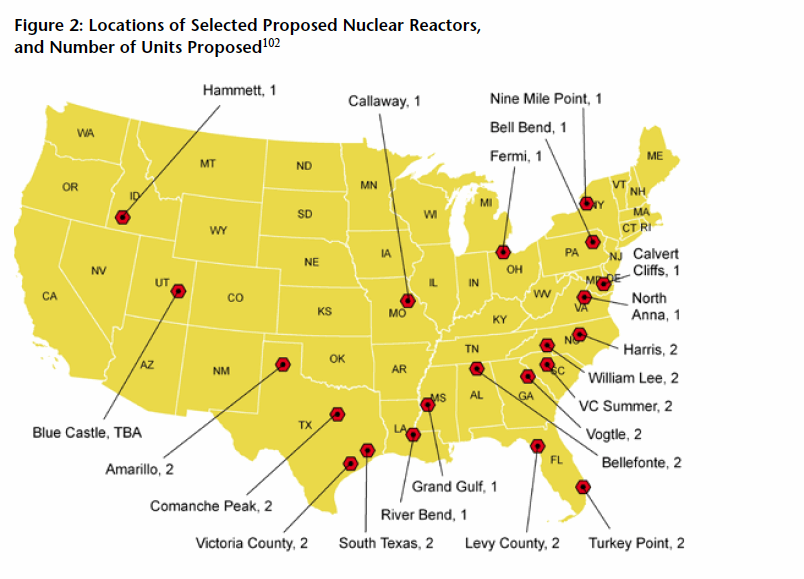U.S. PIRG
Executive Summary
Nuclear power is among the most costly approaches to solving America’s energy problems.
Per dollar of investment, clean energy solutions – such as energy efficiency and renewable resources – deliver far more energy than nuclear power.
This fact has important implications for America’s energy policy. By directing resources toward the most cost-effective solutions, we can make greater progress toward a secure, reliable and safe supply of electricity to power America’s economy.
Dollar for dollar, a clean energy portfolio can deliver more energy than nuclear power. Per dollar of investment:
Energy efficiency measures can deliver greater than five times more electricity than nuclear power.
Combined heat and power (which generates both useful heat and electricity for a factory, a school campus or an office building) can generate nearly four times more energy than nuclear power.
Wind farms can produce as much as 100 percent more electricity than nuclear power.
A solar thermal power plant in the southwestern U.S. – capable of storing heat to generate electricity even when the sun isn’t shining – can deliver as much as one-third more energy than a nuclear reactor. (See Figure ES-1.)
Since 2005, cost estimates for building a new nuclear reactor have more than tripled.
Estimated costs for nuclear reactors have risen faster than for other types of generation technologies. The nuclear industry in particular faces a shortage of qualified and experienced engineers, manufacturers, and construction workers. For example, only one metal foundry in the world today is capable of forging ultra-heavy reactor vessels – and it is located in Japan.
In June 2008, staff at the Federal Energy Regulatory Commission estimated that building a new 1,000 megawatt (MW) reactor could cost up to $7.5 billion. Moody’s Investor Service estimates that at that price, reactor owners would have to sell electricity at an average of 15 cents per kilowatt-hour (kWh) over the life of the plant in order to earn an adequate profit.
Building all currently planned nuclear power plants could cost $300 billion.
As of February 2009, power companies have announced plans for 30 new nuclear reactors. Altogether, building these reactors could cost as much as $300 billion.
To put this amount in perspective, $300 billion is more than double the estimated cost to repair all the roadway bridges in the United States.
Utilities planning to build new nuclear plants are transferring risks onto taxpayers and consumers – especially in southern states.
In 2005, Congress created a series of taxpayer-financed subsidies to support the construction of new nuclear reactors, including loan guarantees, extended liability insurance, and a tax credit for every kilowatt-hour of nuclear electricity generated. Altogether, the subsidies are valued at as much as 60 to 90 percent of the levelized cost of power from a new nuclear reactor – reaching as high as $13 billion for a single reactor.
Many regulated utilities working to build new nuclear capacity are charging customers up-front to finance reactor construction – with no guarantee of final cost, or even a guarantee that the plant will ever deliver electricity at all. For example, Florida regulators are allowing Progress Energy to start billing customers in 2009 for the planning, development and construction of two nuclear power plants that will not begin delivering electricity until 2016 at the earliest. As construction proceeds, residential customers could end up paying as much as $25 more a month to finance the nuclear reactors.
Other utilities planning advance charges include Georgia Power, South Carolina Electric & Gas, Santee Cooper in South Carolina, and Ameren in Missouri.
Investing in clean energy solutions rather than a fleet of new nuclear power plants would yield greater benefits for America.
The United States has vast clean energy resources. The American Council for an Energy-Efficient Economy – composed of some of the nation’s leading experts on energy efficiency – estimates that the United States could cost-effectively reduce its overall energy consumption by 25 to 30 percent or more over the next 20 to 25 years. Progress at this level would ensure that America uses less energy several decades from now than we do today, even as our economy grows. At the same time, America’s entire electricity needs could be met by the wind blowing across the Great Plains or the sunlight falling on a 100 mile square patch of the desert Southwest, or a tiny fraction of the natural heat just beneath the surface of the earth anywhere across the country.
Directing $300 billion into energy efficiency could eliminate growth in America’s electricity consumption through 2030 and save consumers more than $600 billion. Energy savings in 2030 would be equivalent to the output of more than 80 nuclear reactors. Alternatively, $300 billion could buy enough wind turbines to supply on the order of 10 percent of America’s projected electricity needs in 2030 – equivalent to the output of more than 40 nuclear reactors.
Research by the European Renewable Energy Council shows that clean energy resources in the United States could deliver substantial pollution reductions at half the cost and with twice the job creation that could be achieved with nuclear power and fossil energy sources.
Download full report (PDF): The High Cost of Nuclear Power
About U.S. PIRG
www.uspirg.org
“With a strong network of researchers, advocates, organizers and students in state capitols across the country, we take on the special interests on issues, such as product safety,political corruption, prescription drugs and voting rights,where these interests stand in the way of reform and progress…U.S. PIRG’s mission is to deliver persistent, result-oriented public interest activism that protects our health, encourages a fair, sustainable economy, and fosters responsive, democratic government.”
Tags: nuclear, Solar Energy, U.S. PIRG, Wind Energy








 RSS Feed
RSS Feed